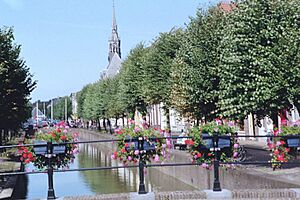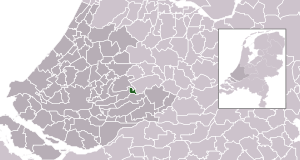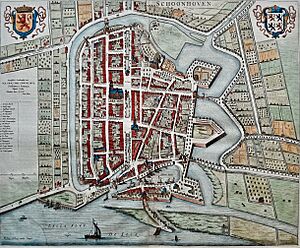Schoonhoven facts for kids
Quick facts for kids
Schoonhoven
|
|||
|---|---|---|---|
|
Town and former municipality
|
|||

Canal in Schoonhoven
|
|||
|
|||

Location in South Holland
|
|||
| Country | Netherlands | ||
| Province | South Holland | ||
| Municipality | Krimpenerwaard | ||
| Area | |||
| • Total | 6.92 km2 (2.67 sq mi) | ||
| • Land | 6.27 km2 (2.42 sq mi) | ||
| • Water | 0.65 km2 (0.25 sq mi) | ||
| Elevation | 3 m (10 ft) | ||
| Population
(2023)
|
13,570 | ||
| • Density | 1,898/km2 (4,920/sq mi) | ||
| Source: CBS, Statline. | |||
| Demonym(s) | Schoonhovenaar | ||
| Time zone | UTC+1 (CET) | ||
| • Summer (DST) | UTC+2 (CEST) | ||
| Postcode |
2870–2871
|
||
| Area code | 0182 | ||
Schoonhoven is a town in the western Netherlands. It is located in the province of South Holland. Until 2015, Schoonhoven was its own independent municipality. Now, it is part of the larger Krimpenerwaard municipality.
In 2023, about 13,570 people lived in Schoonhoven. The town is known for its beautiful canals and historic buildings. It is also famous for its silver industry.
Contents
History of Schoonhoven
Early Beginnings and Town Rights
Around the year 1220, a castle was built in Schoonhoven. It was located near a small stream called "Zevender," close to where it met the Lek River. The town of Schoonhoven grew around this castle.
The first time Schoonhoven was mentioned in a document was in 1247. It was called Sconhoven back then. In 1280, Schoonhoven was officially given town rights. This meant it could govern itself more.
Town Walls and Economy
Around 1350, people built walls and gates around the town. These defenses helped protect Schoonhoven. The town's economy relied on shipping goods, brewing drinks, fishing, and farming. Schoonhoven was also a busy marketplace for the area.
In 1518, the castle burned down. Its remains were removed over the next few decades.
Fortifications and Changes
Between 1582 and 1601, the town's defense walls were rebuilt and made bigger. They even included the shipyards. These defenses mainly faced east. This was because Schoonhoven was in a key spot between the County of Holland and the Bishopric of Utrecht.
After the "Disaster Year" of 1672, the walls were made even stronger. They were also extended to the west and north. However, by 1816, these old defenses were no longer useful for warfare. Most of them were torn down. A cemetery and a park were built in their place.
Today, most of the old town walls and gates are gone. The only remaining medieval entrance gate is the Veerpoort (Ferry Gate). It faces the Lek River. This gate protected Schoonhoven from floods, including the big North Sea flood of 1953. It still works as a water barrier today.
By 1860, about 2,900 people lived in the town. Schoonhoven did not grow much outside its old fortress limits until the mid-1900s.
What to See and Do in Schoonhoven
The Silver Town
Schoonhoven is famous for its silver. It is often called Zilverstad, which means "Silver Town." Since the 1600s, many silver and gold workers have lived and worked here.
Today, Schoonhoven is still known for its silver. You can visit "Het Nederlands Zilvermuseum" (the Dutch Silver Museum). There is also the International Silver School in town.
Clocks and Other Sights
Schoonhoven is also known for making clocks. You can still find several clock makers in town. Some of them welcome visitors. A beautiful example of a large clock is the Van den Gheyn Beiaard. This clock is in the tower of Schoonhoven's medieval town hall.
Visiting Schoonhoven
The town is a popular stop for river cruise ships, especially in summer. Tourists often take guided tours of the town and its museums. Many also enjoy cycling trips through the countryside around Schoonhoven.
The grassy areas around Schoonhoven are called polders. These areas are home to many different birds, including storks.
Fun Events
Schoonhoven hosts several popular events each year. These include the annual Silver Day (Zilverdag) on Whit Monday. "Spookhoven" is a fun celebration of Halloween. The town also celebrates Koningsdag (King's Day) and the arrival of Sinterklaas every year.
Schoonhoven has two main shopping streets. You can find many shops and boutiques there. There are also several restaurants, bars, a hotel, and a discotheque.
Getting Around Schoonhoven
Road and Bus Connections
Schoonhoven is located in the middle of the "Groene Hart" (Green Heart) of the Netherlands. This is a mostly rural area. Because of this, Schoonhoven does not have a train station.
You can reach Schoonhoven by car from major cities like Rotterdam and Utrecht in about 30 minutes. The N210 road connects to these cities. From Gouda, you can take the N207. There are also frequent bus connections (lines 295 and 497) to these cities. Amsterdam is about an hour away by car.
Ferry Across the Lek River
A ferry crosses the Lek River, connecting Schoonhoven with Gelkenes. This ferry carries both cars and people. From Gelkenes, you can easily reach towns like Gorinchem, Dordrecht, and Kinderdijk in about 30 minutes.
Notable People from Schoonhoven
- Martin van Bruinessen
- Rick Karsdorp, a professional football player from the Netherlands.
- Olivier van Noort, the first Dutchman to sail all the way around the world. You can see his statue outside the ferry gate, looking out over the river.
Trivia
- Schoonhoven was once a fortified town. It was part of the Old Hollandic Water Line, a defense system using water.
Images for kids
-
Bartholomew church
See also
 In Spanish: Schoonhoven para niños
In Spanish: Schoonhoven para niños

















